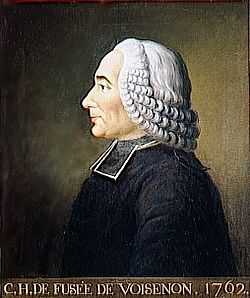Claude-Henri de Fusée de Voisenon

Claude-Henri de Fusée, abbé de Voisenon (July 8, 1708 – November 22, 1775) was a French dramatist and writer.
Born at the château de Voisenon, in Voisenon, near Melun, he was only ten when he addressed an epistle in verse to Voltaire, who asked the boy to visit him. They remained friends for fifty years. Voisenon made his début as a dramatist with L'Heureuse resemblance in 1728, followed in 1739 by a three-act comedy L'Ecole du monde at the Théâtre Français. This was preceded by a verse prologue, L'Ombre de Molière, and a month later Voisenon produced a criticism of his own piece in Le Retour de l'ombre de Molière.
A duel provoked by Voisenon inspired him with remorse, and he entered the priesthood, becoming vicar-general to the Bishop of Boulogne. He received the abbey of Jard, which made no demands on him. He became closely attached to Madame du Châtelet, the mistress of Voltaire, and was intimate with the comte de Caylus and Mademoiselle Quinault Dufresne. He made witty but by no means edifying contributions to the trennes de Saint-Jean, the Bals de Bois, etc.
In 1744 he produced the Ménages assortis and in 1746 his masterpiece, the Coquette fixée. He was a close friend of Charles Simon Favart and his wife. His pen was always at the service of any of his friends, and it was generally supposed that he had a considerable share in Favart's most successful operas. Voisenon had scruples all his life about the incongruity between his way of living and his profession, but he continued to write indecent stories for private circulation, and wrote verses in honor of Madame du Barry, as he had done for Madame de Pompadour.
He was elected to the Académie française in 1762. On the disgrace of his patron, the duc de Choiseul, he lost his pensions and honours, but soon recovered his position. He was intimate with the chancellor Maupeou, and was suspected of writing on his behalf in defence of the abolition of the parlement. This and some other incidents brought him into general disgrace. Early in 1775 he retired to the château de Voisenon, where he died.
His Œuvres complètes were published by his executrix, Madame de Turpin, in 1781.
References
 This article incorporates text from a publication now in the public domain: Chisholm, Hugh, ed. (1911). Encyclopædia Britannica (11th ed.). Cambridge University Press.
This article incorporates text from a publication now in the public domain: Chisholm, Hugh, ed. (1911). Encyclopædia Britannica (11th ed.). Cambridge University Press.
| ||||||
|